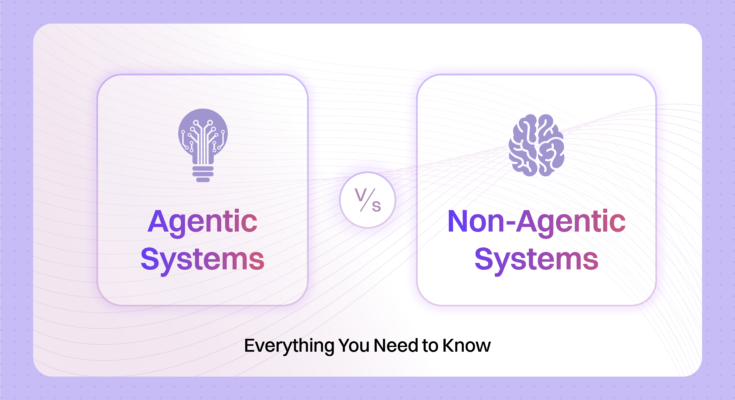As the demand for smarter, more efficient applications grows, so does the need for architectures that can support complex data flows in real-time. Traditional models often struggle with scalability and adaptability, which is why Agentic Architecture is rapidly becoming the foundation for next-gen applications.
By leveraging AI and decentralized principles, Agentic Architecture allows data to flow dynamically, enabling applications to make autonomous decisions, learn, and adapt over time.
To know more about how this technology is transforming the way we build and deploy systems, check out this article here.
What is Agentic Architecture?
Agentic Architecture represents a shift from traditional centralized models to a more decentralized, dynamic approach to data handling and decision-making. In this new paradigm, applications are designed to be more autonomous, with the ability to process and analyze data locally, without needing to rely on central systems for every decision.
At its core, Agentic Architecture is about empowering applications to act as “agents” that can make decisions and adapt their behavior based on data inputs, interactions, and even environmental factors. This flexibility makes it an ideal architecture for the next generation of applications that require scalability, flexibility, and real-time data processing.
Understanding the foundation of Agentic Architecture is essential, but it’s equally important to look at how it impacts data flow and application performance. Let’s now explore the role of data flow in next-gen applications and how Agentic Architecture ensures that data is processed and delivered more efficiently.
Key Features of Agentic Architecture
Let’s check out its key features:
- Decentralized Decision-Making: Unlike traditional architectures that rely on central hubs, Agentic Architecture distributes decision-making across multiple agents, ensuring faster response times and improved fault tolerance.
- Real-Time Data Flow: By enabling real-time processing, Agentic Architecture reduces latency and supports the rapid analysis and action that modern applications demand.
- Autonomous Adaptation: Applications built on Agentic Architecture can learn and evolve over time, adjusting to new inputs and changing environments without human intervention.
The Role of Data Flow in Next-Gen Applications
In next-gen applications, data flow is a critical element that drives everything from performance to user experience. Traditional architectures often struggle to handle the massive, real-time data streams that are now commonplace, leading to bottlenecks, slowdowns, and inefficiencies. Agentic Architecture provides a solution by allowing data to flow more freely and efficiently across decentralized systems.
This approach allows applications to seamlessly process large volumes of data without compromising performance or security. It also ensures that decision-making processes are closer to the data source, allowing for faster, more accurate responses.
Now that we understand how Agentic Architecture helps manage data flow, let’s dive into how it benefits developers by streamlining the development process and creating more reliable, scalable applications.
Benefits of Real-Time, Decentralized Data Flow
Here’s how Agentic architecture stands out:
- Improved Efficiency: By distributing data processing and decision-making, Agentic Architecture ensures that each agent can work independently, speeding up overall system performance.
- Scalability: Decentralized systems can scale more easily as the need for additional processing power grows. With Agentic Architecture, new agents can be added dynamically to handle increasing loads without disrupting the system.
- Enhanced Security: Decentralization reduces the risk of single points of failure, which are common in traditional, centralized architectures. This makes systems more resilient to attacks and failures.
How Agentic Architecture is Changing the Game for Developers
For developers, the shift to Agentic Architecture represents a new way of thinking about application design. Instead of building systems that are rigid and reliant on centralized hubs, developers can create flexible, self-sustaining applications that are more adaptable to change.
Agentic Architecture offers several advantages for developers, including faster development cycles, more reliable systems, and enhanced collaboration across teams. With decentralized systems, developers can focus on creating specific agents that handle particular tasks, rather than managing the complexity of central systems.
As developers continue to adapt to Agentic Architecture, they’ll need to streamline their processes to take full advantage of its benefits. Let’s explore how this new architecture influences development workflows and supports faster iteration and greater collaboration.
Streamlined Development Processes
Let’s learn more about how this architecture streamlines development processes:
- Modular Design: By breaking down applications into smaller, autonomous agents, Agentic Architecture makes it easier for developers to build, test, and deploy new features or updates without disrupting the entire system.
- Faster Iteration: With real-time data processing and decentralized decision-making, developers can quickly identify and fix issues, leading to shorter development cycles and faster time-to-market for new applications.
- Improved Collaboration: Teams can work on separate components (agents) in parallel, making it easier to manage complex projects and maintain high levels of collaboration.
The Future of Applications with Agentic Architecture
As we look ahead, the potential of Agentic Architecture in the development of next-gen applications is enormous. From AI-driven apps to decentralized financial systems, the ability to process and adapt to real-time data at scale opens up new possibilities for innovation.
In the coming years, Agentic Architecture is likely to play an even more significant role as applications continue to grow more complex and data-driven. By allowing applications to function more autonomously, with real-time decision-making capabilities, organizations will be better equipped to meet the demands of an increasingly dynamic and interconnected world.
With such potential, it’s exciting to think about the new use cases that Agentic Architecture will enable. Let’s explore how this architecture could be applied to emerging technologies and industries.
Exploring New Use Cases for Agentic Architecture
The following are the upcoming use cases of this architecture:
- Autonomous Vehicles: With Agentic Architecture, self-driving cars can process vast amounts of data from their surroundings and make real-time decisions about navigation, safety, and route optimization.
- Smart Cities: Decentralized systems powered by Agentic Architecture can help manage and analyze data from IoT devices across a city, improving everything from traffic management to energy usage.
- AI-Powered Healthcare: By using Agentic Architecture, healthcare systems can process patient data more effectively, enabling real-time diagnostics and personalized treatments.
Conclusion
Agentic Architecture is revolutionizing the way data flows through applications, offering benefits like improved efficiency, scalability, and security.
As businesses and developers continue to embrace this new architecture, we’ll see an increasing number of applications that can adapt and learn in real-time, creating a smarter, more connected world.




